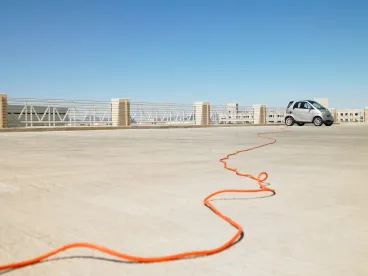The 2021 Infrastructure Investment and Jobs Act (IIJA) provided $1.2 trillion in federal funding for infrastructure, including approximately $384 million to support California EV infrastructure through the National Electric Vehicle Infrastructure (“NEVI”) formula program. This sum supplements significant State investments, bringing California funding dedicated to expanding EV Infrastructure to nearly $3 billion through 2026.
The federal NEVI formula program adds to a growing and varied list of California programs that provide funding and incentives for the EV charging infrastructure necessary to support California’s goals of phasing out the sale of new gasoline-powered passenger vehicles by 2035, and transitioning all medium- and heavy-duty (“MD/HD”) vehicles to zero-emission vehicles by 2045.
However, many of the existing State programs, as described below, support facilities serving only MD/HD vehicles, cap funding, or have eligibility criteria that limits funding to certain places or applicants. The NEVI formula program provides the first major source of funding that will support light-duty EV infrastructure development through a state-level competitive solicitation process. Scoring criteria and application requirements are to be developed through a public process including public workshops and comments over the next year, with applications expected to be accepted in late 2023 or early 2024.
California NEVI Formula Program Plan and Standards
Both a draft California NEVI Deployment Plan and proposed federal regulations to establish minimum standards and requirements for NEVI-funded projects were published in June with solicitations for public comment. The most significant stage of program development will occur this Fall, however, when California establishes the details of NEVI-funded grant opportunities.
California’s draft Deployment Plan describes the State’s high-level visions and goals for NEVI funding, including a commitment to extensive public engagement and outreach to shape the program to meet State goals. The draft Plan identifies “seamless travel,” equity, reliability and emissions reductions as goals that will inform program priorities, as well as an expectation that private sector applicants will provide a 20% funding match. Public comments will inform a final California Deployment Plan to be submitted for federal approval in August.
Federal regulations will establish standards for equipment, operations and software, among other things, to ensure safety, interoperability and a consistent user experience nationwide. Comments are due August 22, 2022, with a final rule expected shortly thereafter.
Much more detail about California’s program requirements, selection criteria and priorities will be included in a draft grant solicitation to be issued in Winter 2022/2023 following federal approval of the California Deployment Plan. The draft solicitation will be the subject of a series of public workshops and comments, culminating in a solicitation for the first round of NEVI funding in late 2023 or early 2024. Important questions, such as the size and number of grants to be awarded and how selection criteria will be weighed, will shape the program and the application process.
On June 14, the California Energy Commission and the California Department of Transportation held a joint workshop outlining plans for NEVI program implementation.
Existing California EV Charging Funding and Incentive Programs
More than $1 billion in State grant funding has already been distributed through existing California EV charging programs, with $2 billion more to be distributed by 2026. Currently, there are approximately 15,000 installed or planned EV chargers in California—the State goal is to increase that number to 1.2 million by 2030. Much of that funding will be distributed through existing State incentive programs. Below is a brief overview of the State’s major programs.
The Energize Commercial Vehicles (EnergIIZE) Program focuses on infrastructure to support MD/HD battery electric and hydrogen fuel cell vehicles. It includes several funding “lanes” with different requirements:
-
The EV Fast Track Funding Lane supports ZEV infrastructure equipment for MD/HD battery electric and hydrogen fuel cell vehicles. Grants may cover up to 50% of the cost of eligible equipment and software. Funding is awarded on a first-come, first served basis for eligible projects, with a $500k per project cap.
-
The EV Jumpstart Funding Lane assists businesses establishing a ZEV fleet of MD/HD commercial vehicles for the first time. Applicants must meet eligibility criteria as a Minority Business Enterprise, Woman-Owned Small Business, Veteran-Owned Small Business, or LGBT-Owned Small Business. This program funds up to 75% of eligible EVSE for MD/HD electric vehicles up to $750k per project.
-
The EV Public Charging Station Funding Lane supports publicly-accessible charging and fueling stations that serve MD/HD vehicles. This program funds up to 50% of project costs with a $500k per project cap. Applicants that meet EV Jumpstart eligibility criteria, which requires a demonstration of need or demand, may qualify for 75% funding with a $750k per project EV charger cap.
The California Electric Vehicle Infrastructure Project (CALeVIP) is dedicated to serving light-duty vehicles through programs administered at the regional or local levels.
-
Regional Incentive Programs promote the installation of Level 2 & DC Fast Chargers in coordination with regional transportation agencies and counties. Available funding levels and eligibility criteria vary, with portions of funding reserved for projects located in disadvantaged communities (i.e., disproportionately burdened by, or/or vulnerable to, pollution) or low-income communities. Links to thirteen regional programs are posted on the CALeVIP website.
-
City-Based Incentive Programs. At least nine Southern California cities, including Los Angeles, Pasadena, Burbank, and Anaheim, have established local incentive programs for commercial and residential chargers. More information on city-based incentives is available through the CALeVIP website.
Incentives through CPUC, LCFS and WAIRE Programs. The California Public Utilities Commission (CPUC) has approved a range of EV charging infrastructure incentive programs through the State’s electricity providers. For example, PG&E offers special subscription-based rates to businesses with on-site EV charging; SCE is authorized to dedicate $436 million to support the installation of 37,800 electric vehicle charge ports through its “Charge Ready” program; and SDG&E offers the “Power Your Drive” program, including rebates for charging stations at multi-family dwellings, commercial properties, schools, parks & beaches.
California’s Low Carbon Fuel Standard (LCSF) program also offers significant though less direct support for EV infrastructure by generating LCFS credits that then can be sold. The program provides an extra incentive during the first five years following construction of an EV charging station: LCFS credits are earned at the station’s full capacity, not actual sales, thereby providing a larger and more predictable revenue stream. Warehouse facilities located within the South Coast Air Quality Management District can earn credits to meet Warehouse Actions and Investments to Reduce Emissions (WAIRE) Program requirements by installing or using EV charging stations.
This listing of EV charging infrastructure support available to California businesses and companies is not comprehensive. For example, the IIJA included $2.5 billion in federal funding for a discretionary grant program, with funding for rural areas, low-and moderate-income neighborhoods and communities with a low ratio of private parking spaces. Rules and guidance for the program are under development.



 />i
/>i

